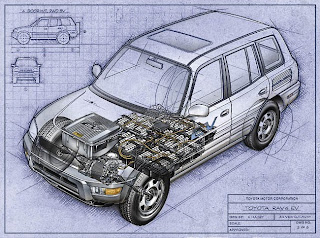
 New Design Concept Embryo Car Future
New Design Concept Embryo Car Futurebasic4automotive.blogspot.com Your Internet Automotive Links Directory offers everyone a great starting place for their car search, whether your looking for discount car parts and accessories, car repair help and advice, auto news and car related articles or just simple car information for your car, truck,or motorcycle
|
|
|
|---|
Shell has shut three flow stations after its oil pipeline in the Niger Delta was sabotaged.
Recent attacks have resulted in $1bn a month in lost revenue.
[Source: bbc.com]
For a couple of years now, the dream ride has been in a Tesla Roadster. You strap in, feel the instantaneous surge of power, maneuver the curves above Palo Alto on electrons.
The next ride won't be the Tesla S Sedan, it will be Tesla the stock.
Tesla Motors has filed an IPO plan with the SEC to raise $100,000,000 in a public offering.
Tesla will stop production of the Roadster in 2011. The electric sedan is meant to appear in 2012.
West Africa's burgeoning oil industry has a pirate problem.
On Jan. 5 Nigerian pirates stormed a Panamanian-flagged Ukrainian tanker, the Westaf, anchored off Lagos, Nigeria's commercial capital, according to the Sovfracht Maritime Bulletin published in Kiev.28 attacks were logged in 2009 compared with 40 a year earlier. But shipping sources suggested that there were another 30 attacks last year that went unreported. Most were related to the oil industry.
They robbed the crew, shooting and wounding the captain and six of his men. The Westhaf, built in 1986, is used as a floating storage and processing terminal.

 New Design Concept Embryo Car Future
New Design Concept Embryo Car Future

Darryl Siry blogs over at Wired's Autopia. He's pretty plugged in, having worked at Tesla and consulted for CODA. He's a bit surprised, as are all of us, that Nissan has emerged as the first big automaker to manufacture a mass-produced electric car.
In his recent post, "In Race to Market, Nissan’s Electric Car Takes Shortcuts," Siry makes the point that CEO Carlos Ghosn's enthusiasm and charisma alone couldn't be enough to get such a job done so quickly. He writes that the urgency of the project "appears to have driven the company to take some shortcuts."
Sounds ominous. Ultimately, I'm not sure what he's actually getting at. Because Siry makes only two points. Neither of certain significance.
First, he suggests Nissan overstates the range of the LEAF. The 100 mile range cited by Nissan uses "a number tied to the most optimistic benchmark, the LA4 cycle." I don't doubt that this is true. The LEAF pack has fewer kWh than my RAV4 EV, but could be almost as heavy. Until we get final specs on weight, and drive the car around a bit, we won't know to what extent people will need to handicap official range numbers as they do EPA gasoline mileage ratings. Big surprise, your actual mileage may vary. Buyer beware!
Second, and the point on which the article devotes most attention, is whether Nissan is "cutting corners" by forgoing an active thermal management (HVAC) system for the batteries. Instead Nissan is relying on air circulation with a fan.
corners" by forgoing an active thermal management (HVAC) system for the batteries. Instead Nissan is relying on air circulation with a fan.
Now I don't know whether something about lithium, regardless of chemistry or packaging, will prove to require an active system. But I do know, interestingly and perhaps relevantly, that the electric car that has probably driven more miles than any other model, the Toyota RAV4 EV, does not have batteries with an active system. A fan circulates air. The Honda EV+ used the same Panasonic EV-95 NiMH battery modules with an active system, and those packs didn't last as long. Many EV+ packs were exchanged during their brief time on the road. At least with NiMH, Toyota's passive system worked out better in the real world. Of course the cooling system may have had nothing to do with the the difference in performance of the same batteries in two Japanese EVs, but we'll never know.
Siry notes the different approach being taken by GM for the Volt. They reverted to the T-shaped tunnel configuration for the battery used in the EV1. (How did that work out?)
I may be approaching this too simply, but the tunnel has never made sense to me. It eliminates the possibility of a fifth passenger seat. And I find it makes me feel confined. The batteries, too, enshrouded on three sides, require, apparently, an active thermal management system.
The RAV, on the other hand, suspends the batteries below the vehicle. There is minimal loss in cabin space and a large surface below helping dissipate heat, which is an issue with NiMH, too. And we find that the LEAF's battery pack, too, will be located under the floorboard. Maybe that's the key. Keep the batteries low and spread them wide.
I don't know, of course, but I'm willing to give Nissan the benefit of the doubt.
I'm giving Tesla and CODA and GM the benefit of the doubt, too.
A tanker truck clipped a car.
The tanker flipped over and burst into flames "creating a fireball seen for miles."
The driver was killed.
The Long Island Expressway was closed for hours in both directions.
A typical tanker truck holds between 5000 and 9000 gallons of gasoline.
Two vessels collided in Port Arthur, Texas.
As much as 450,000 gallons of crude oil spilled.
Some nearby residents have been evacuated from the area because of hydrogen sulfide that was emanating from the oil.
[Source: RawStory.com]
|
|